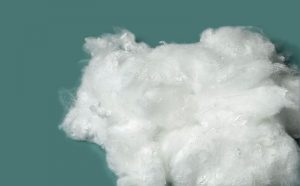
Eastman Chemical engaged Rieter when it wanted to extend its Naia™ cellulosic product into staple fiber yarns.
TW Special Report
Global specialty chemicals company Eastman Chemical Co., Kingsport, Tenn., turned to Switzerland-based Rieter regarding a process consultancy for its new staple fiber. The cellulosic fiber Naia™ already existed as a filament yarn and can now be utilized for a wider range of textile applications. Eastman and Rieter worked together to find the right blends and yarn counts for the Naia staple fiber to increase its market penetration, while giving fashion brands a truly sustainable choice.
Eastman turned to Rieter for help in developing a new staple fiber, made from cellulosic acetate. To increase market penetration, and bring the Naia fiber to more textile applications, Eastman decided to also offer it in the form of a staple fiber as well as a filament yarn.
This is where Rieter came into play. Rieter has broad experience across all spinning systems and in processing all types of staple fibers from bale to yarn. The company’s expertise also extends to processing and testing further applications of the yarns in the downstream process.
The eco-conscious blends created with the Eastman Naia staple fiber are supremely soft and dry quickly. Naia consistently reduces pilling, giving designers more freedom and choice. The fiber is produced using wood pulp and sourced from sustainably managed pine and eucalyptus forests. It is produced in a safe, closed-loop process where solvents are recycled back into the system for reuse and without the use of hazardous chemicals. The manufacturing process has a low tree-to-fiber carbon and water footprint. This, combined with biodegradable certification, results in a sustainable material that is perfect for T-shirts, comfort wear, jumpsuits, sweaters and dresses, and delivers a truly sustainable option to fashion brands globally.
First Trials With Naia — Understanding The Fiber
The cellulosic fiber used in Rieter’s first trials brought to light some challenges. By more deeply studying and understanding the characteristics of the cellulosic fiber, the technologists targeted their process approach and shared their intermediate learnings.
New Fiber, New Blends
The second set of trials showed more promise. Building on the initial trial results, Eastman went back to its laboratories and further developed the Naia staple fiber, improving the fiber’s processability. A noteworthy improvement in the carding process resulted in a high-quality sliver.
Rieter’s textile technologists continued to process the different blends with polyester, modal and lyocell fibers. This included winding cones, spun conventional ring yarn and compact-twin yarn made from each blend in Rieter’s spin center at the company’s headquarters in Winterthur, Switzerland. It spun single ring yarns in Ne 30 and Ne 40 counts, and compact-twin yarns in Ne 40 and Ne 60 counts. Running performance throughout fiber opening and carding was smooth. The Naia staple fiber performed well on the draw frames, and sliver was produced with acceptable uniformity. All blends could be processed with normal production speed.
Process Recommendations For Eastman
After all the tests and trials, the Rieter textile technologists gained a good understanding of what is possible with the Naia fiber. Learnings from the trials were shared with Eastman for further evaluation and testing. In addition, Rieter trained the Eastman team, including technical sales, on the process recommendations, machine settings and blend ratios to spin the best version of the fiber. The Naia staple fiber was launched into the market in February 2020. Leading global fashion retailer H&M was first to market with its Conscious Exclusive Autumn/Winter 2020 collection made with Eastman Naia Renew cellulosic fiber.
January/February 2022




